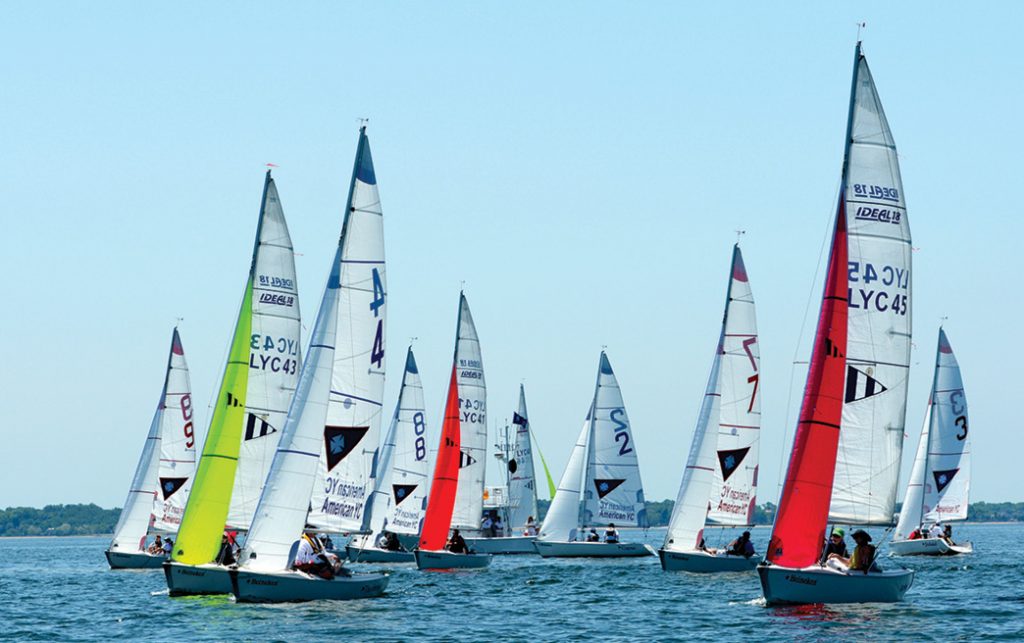By David Dellenbaugh
When you come off the starting line on starboard tack, it’s tempting to relax a little because you are finally getting away from the frenzied crowd. If you want to do well, however, you really need to focus on a new set of post-start priorities. Here are a bunch of questions you should consider as soon as you start racing up the beat. Use the answers to help plan your immediate tactical and strategic actions.
Were you over the line early? You have to know this as soon as possible. If there is any chance you were OCS, listen for one sound signal and check to see if the RC is flying the X flag. Then make a decision to go back or not. If you think there was a general recall, don’t head back until you are absolutely sure.
Are your sails trimmed optimally? The first few minutes after your start is the most critical time for going fast, so make sure your sails are set properly for the existing conditions. Many sailors do a “final check” of their sail trim with 10 or 5 minutes left before the start, but then they don’t look at the sails again until they are racing. A lot can change with the wind in that amount of time.
How is your speed and height relative to nearby boats? Other race boats are your best guide to good boatspeed, and right after the start may be the first time when you have a decent line-up. So use them to make sure you are going as fast as possible. Compare your relative speed and height immediately after the start, and make any necessary trim adjustments as soon as possible. You want to sail at least as fast and as high as the boats on either side of you so you can maintain your lane of clear air. If you are slower or lower, you will fall back into the pack instead of popping out in front.
Can you “hang on” where you are? This is a critical question as you come off any starting line. Will you be able to keep sailing in clear air on starboard tack, or will another boat force you to tack sooner or later? It’s good to answer this question quickly because if you won’t be able to hang in there on starboard, you may want to tack as soon as you have an opening.

If you want to keep sailing smart, you must always keep an eye out for changes in the wind and current. These happen frequently and may require that you revise your strategic plan at any time during the race.
Are you headed or lifted? As I said above, the wind direction and velocity can change a lot between the last time you checked it and the start. So as soon as you get to a close-hauled course off the line, look at your starboard-tack compass heading and compare this to the numbers you were seeing on starboard tack before the start. Are you headed, lifted, or somewhere near your median heading? This is important to know because if you are headed you may want to tack right away; if you’re lifted you probably want to hold on starboard.
How is your position in the fleet? Take a quick look around at the other boats and note where you are in the fleet. Are most of the other boats to your left, your right or all around you? This is important strategically since it could affect whether you stay on starboard tack and go farther left, or tack and head toward the right. Also, are you near the front of the fleet or the back? Are you happy with your position at this moment, or will you be happy only if you improve your standing a lot? This will determine how much risk you are willing to take in the minutes after the start. It will also influence your tactical priorities; for example, are you primarily trying to stay ahead of (cover) the boats behind you, or will you attempt to pass the boats ahead?
What is your strategic plan and how can you follow it? Do you remember the strategic plan that you made before the start? Hopefully, the answer is yes because now is the time when you need all that good thinking and planning as your guide. If necessary, verbalize your first-leg strategy to the rest of your crew. Then use your tactical moves to start implementing your gameplan. ■
This article originally appeared in David Dellenbaugh’s Speed & Smarts, The newsletter of how-to tips for racing sailors. If you want to sail faster and smarter, log onto SpeedandSmarts.com.
A resident of Easton, CT, Dellenbaugh was tactician and starting helmsman for America3’s successful defense of the America’s Cup in 1992. He’s a Lightning World Champion, two-time Congressional Cup winner, seven-time Thistle National Champion, two-time winner of the Canada’s Cup, three-time Prince of Wales U.S. Match Racing Champion, and a winner of the U.S. Team Racing Championships for the Hinman Trophy.



